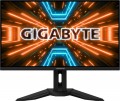Size
Diagonal size of the monitor matrix, in inches.
This parameter is one of the most important for any screen — it determines the total size of its working area. In general, it is believed that larger monitors are more comfortable: a large screen allows you to see a large fragment of text, images, etc. without having to scroll the "picture". On the other hand, the diagonal directly affects the dimensions, weight and cost of the monitor. In addition, it is worth remembering that screens with the same diagonal can have different aspect ratios and different specializations: for example, widescreen models are convenient for playing games and watching movies, while classic
4:3 or 5:4 solutions are preferable for working with documents. Now there are monitors of different diagonals on the market, among them the most popular are:
19–20",
22",
23 – 24",
25 – 26",
27 – 28",
29 – 30",
32",
34" and
more.
Response time (GtG)
The time each individual pixel on the monitor takes to switch from one state to another. The
lower the response time, the faster the matrix responds to the control signal, resulting in less delay and better image quality in dynamic scenes.
Note that in this case, the gray-to-gray method is used (the time it takes to switch from 10% gray to 90% gray). Pay attention to this parameter if the monitor is specifically purchased for fast-paced games, movie watching, or other applications involving quick screen movements. However, there’s no need to chase the fastest models. It’s not often possible to discern the difference between
1 ms and
5 ms. For most scenarios,
monitors with a 4 ms response time will suffice. In any case, it’s best to rely on live impressions for a true comparison.
Portrait pivot
The screen is 90° rotatable on a stand, from landscape (horizontal) to portrait (vertical). The vertical orientation of the screen (
portrait mode) can be useful, for example, when working with large documents made in portrait orientation.
Speakers
The presence of the monitor's own
built-in speakers. Such models, in fact, combine a screen and speakers, which can save the user from having to purchase separate acoustics. And for models with a TV tuner (see above), this function is almost mandatory. However note that the power of such speakers and the quality of their sound are relatively low, so such a system is hardly suitable for demanding listeners. Nevertheless, built-in acoustics usually sound at least as good as inexpensive external speakers, and take up much less space.
Sound power
Rated power of the speakers installed in the monitor (see "Built-in speakers"). The higher the power, the louder the acoustics can sound, the easier it is to cover a vast space. However, in most cases, the user is directly in front of the monitor, and high volume is not required for normal hearing. So this parameter is critical mainly for plasma and LCD panels (see "Type").
RGB lighting
Availability in the monitor of external backlight RGB.
Such lighting is in the form of LEDs or LED strips embedded in the frame and/or back panel. It performs mainly a decorative function — it gives the monitor an interesting appearance, which is especially appreciated by gamers and modding enthusiasts. The abbreviation RGB means that the backlight can change colour; at the same time, the matter is usually not limited to three basic colours (red-green-blue — red-green-blue), lighting can take on almost any shade. In some models, it can even automatically adjust to the image on the screen — in such a way that the backlight visible to the user improves the overall impression of the picture. There are also backlight systems that can synchronize with other system components (see below for more details).
RGB lighting sync
The timing technology provided by the RGB backlit monitor (see above).
Synchronization allows you to "match" the backlight of the monitor with the backlight of other system components — the case, its hardware (motherboard, processor, graphics card), keyboard, mouse, etc. Thanks to this matching, all components can change colour synchronously, turn on / off at the same time etc. The specific features of the operation of such a backlight depend on the synchronization technology used, and, usually, each manufacturer has its own (Aura Sync for Asus, RGB Fusion for Gigabyte, etc.). The compatibility of the components also depends on this: they must all support the same technology. So the easiest way to achieve backlight compatibility is to collect components from the same manufacturer.

